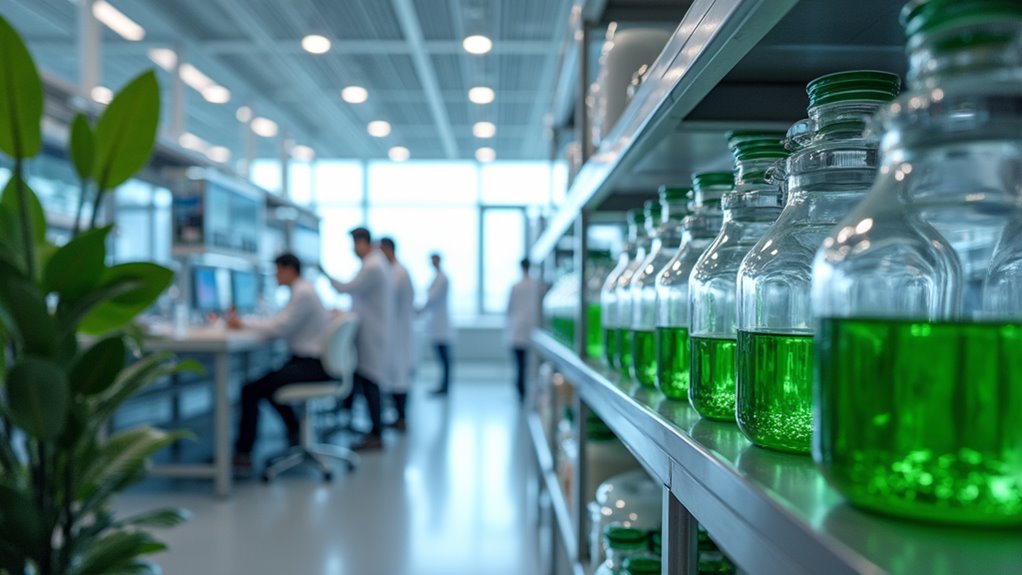To make pharmaceuticals greener and reduce waste, focus on sustainable packaging like biodegradable, recyclable, and reusable materials. Adopt green chemistry techniques, optimize manufacturing with eco-friendly solvents, and increase energy efficiency through renewable energy sources. Industry efforts, coupled with strict regulations, promote cleaner practices. By implementing innovative processes and collaborating across sectors, you can markedly cut environmental impact. Keep exploring to discover how these strategies are shaping a more sustainable pharmaceutical future.
Key Takeaways
- Implement green chemistry techniques to reduce hazardous solvents and improve atom economy in drug synthesis.
- Adopt biodegradable and recyclable packaging materials to minimize plastic waste from pharmaceutical products.
- Utilize continuous flow and enzyme catalysis processes to enhance efficiency and lower environmental impact.
- Incorporate renewable energy sources and energy-efficient routes in manufacturing to decrease carbon footprint.
- Establish waste segregation, recycling, and eco-friendly disposal practices aligned with industry regulations and sustainability goals.
The Environmental Challenges of Pharmaceutical Waste
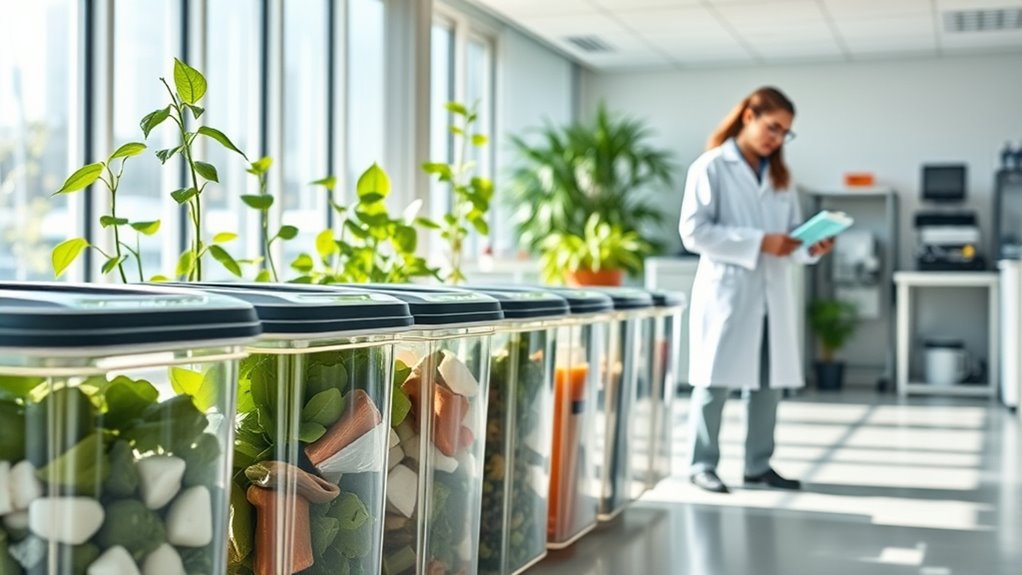
Pharmaceutical waste presents a significant environmental challenge because it enters ecosystems through multiple pathways, including manufacturing discharges, healthcare activities, agriculture, food production, and household disposal.
When medications are improperly discarded or expired drugs are thrown away, they often end up in water systems, soil, and landfills, contaminating the environment. Waste from production includes active pharmaceutical ingredients (APIs), chemicals, and packaging materials that can harm ecosystems.
Healthcare facilities generate mostly non-hazardous waste, but inadequate segregation increases hazardous waste risks, especially in low-income areas. Globally, disposal of syringes, needles, and related materials is often unsafe, contributing to environmental hazards.
These contaminants disrupt aquatic life, promote antimicrobial resistance, and threaten human health through contaminated water and food sources. Managing these challenges requires better waste segregation, disposal, and pollution control strategies, as well as increased waste management efforts to minimize environmental impacts.
Innovations in Sustainable Packaging for Pharmaceuticals
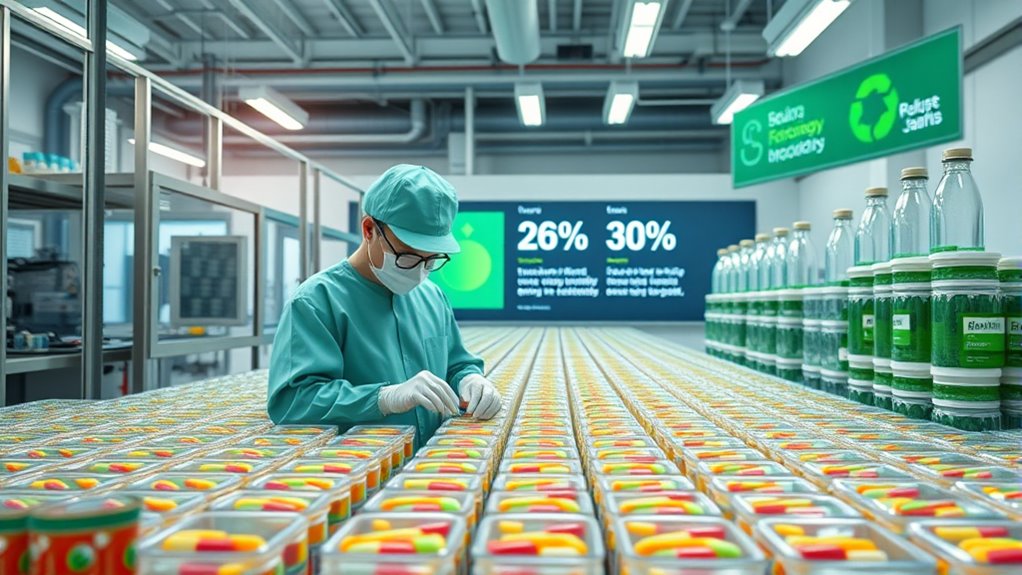
Innovations in sustainable packaging are transforming how the pharmaceutical industry addresses environmental concerns while maintaining product safety. You’ll find biodegradable polymers like PLA and PHA used in blister packs and containers, enabling natural breakdown and reducing landfill waste. Industry emits about 55% more CO2 than the automotive sector. Compostable packaging further decreases plastic pollution, meeting safety standards through advanced engineering. Recyclable designs now favor mono-materials and incorporate post-consumer recycled content, making recycling more efficient and lowering the carbon footprint. Lightweighting efforts reduce material use and transportation emissions, with flexible packaging replacing bulkier options. Reusable systems, such as refillable pill containers, extend product life and cut single-use waste. Collaboration between pharma companies, innovators, and government support accelerates these advances, fostering eco-friendly solutions that balance sustainability with safety and regulatory compliance.
Strategies for Sustainable Manufacturing Practices
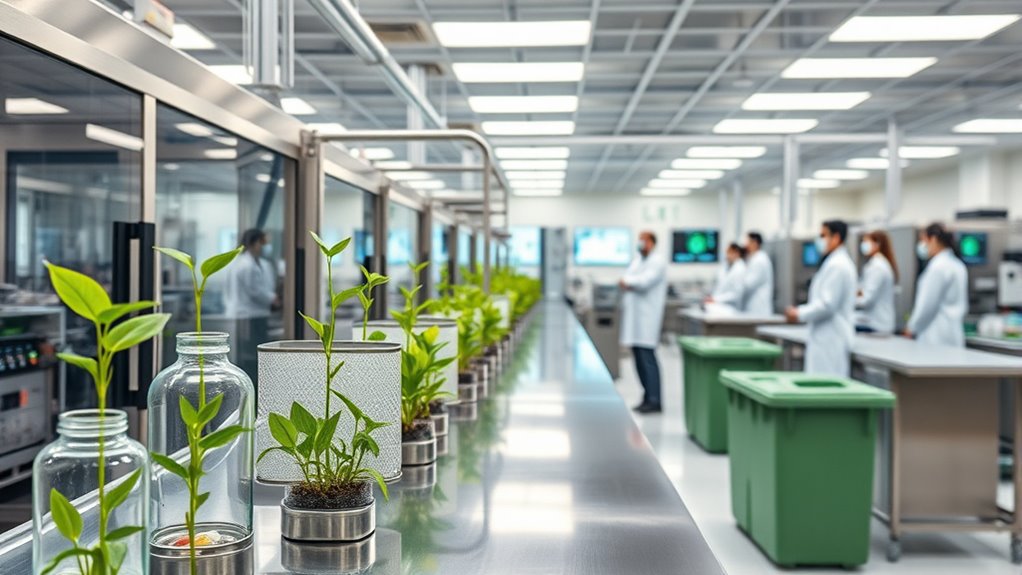
Adopting sustainable manufacturing practices is essential for reducing the environmental footprint of pharmaceutical production. You can achieve this through green chemistry techniques, like using renewable feedstocks and replacing toxic solvents with eco-friendly alternatives. Optimizing synthetic routes minimizes waste and enhances atom economy, while continuous flow chemistry ensures controlled, efficient reactions. Process intensification and automation streamline operations, reducing waste and energy use, with real-time monitoring improving precision. Renewable energy integration, such as solar or wind, cuts reliance on fossil fuels, and energy recovery systems further reduce consumption. Waste reduction involves recycling materials and designing processes for reuse, supporting a circular economy. Implementing renewable energy sources can significantly decrease the carbon footprint of manufacturing facilities, making operations more sustainable. Incorporating sustainable process design ensures that environmental considerations are integrated into every stage of production. Here’s a snapshot of these strategies:
| Strategy | Focus Area |
|---|---|
| Green Chemistry | Eco-friendly reactions |
| Automation | Process control |
| Renewable Energy | Power sources |
Industry Initiatives Driving Green Transformation
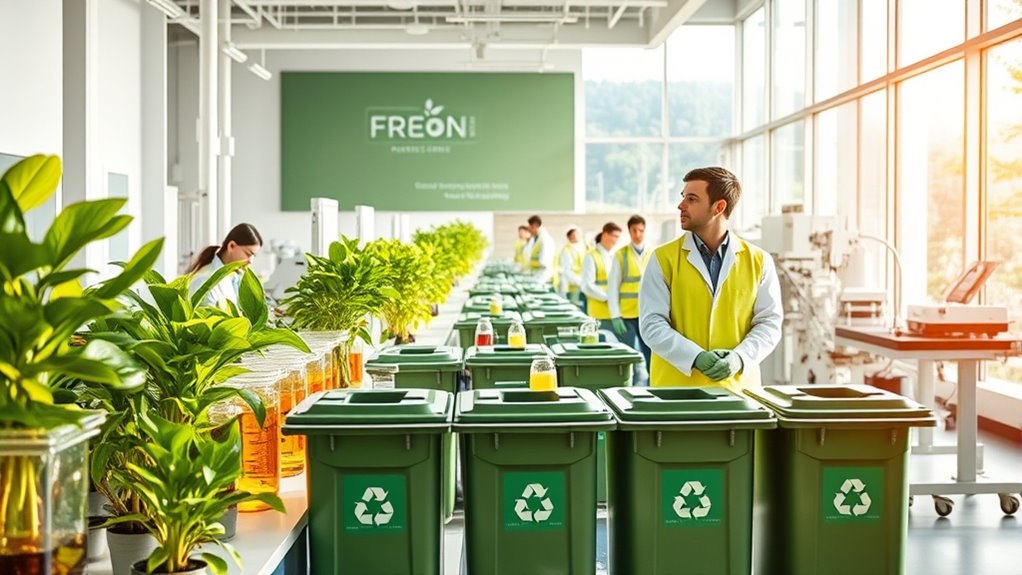
Industry initiatives are propelling the green transformation by setting ambitious targets and integrating sustainability into core operations. You’re part of a sector leading decarbonization efforts, with companies adopting science-based targets to cut emissions across all GHG Protocol scopes—Scope 1, 2, and 3.
Net-zero commitments drive investments in renewable energy and electric transportation, addressing medicine-related emissions, which are significant for organizations like NHS.
Firms are embracing green chemistry, developing eco-friendly solvents, recycling methods, and optimizing processes to reduce resource use and waste.
Embedding ESG frameworks guarantees transparency and accountability, with benchmarks like SBTi guiding progress.
Partnerships with stakeholders, including governments and health systems, accelerate initiatives.
Industry-wide transparency and sustainable procurement practices foster accountability, ensuring the sector’s sustainability goals are met collectively.
Additionally, the adoption of environmentally friendly practices extends to reducing the environmental impact of electric heated mattress pads, promoting energy efficiency and safety in consumer products.
The Role of Regulatory Frameworks and Policies

Regulatory frameworks play a crucial role in steering the pharmaceutical industry toward sustainability. Agencies like the EPA and EU REACH set strict standards that push manufacturers to adopt greener practices. The EU Green Deal’s Chemicals Strategy further promotes sustainable transformation by regulating hazardous emissions and waste disposal. These regulations influence the adoption of eco-friendly techniques, such as solvent reduction and safer chemical substitutes. Since regional rules differ, manufacturers must tailor their sustainability efforts to local requirements, like the CSRD in the EU or U.S. state regulations. Regulatory bodies are expanding their assessments to include environmental impact, encouraging innovations that reduce ecological risks. Implementing these regulations often requires significant investment in new technologies and processes. International initiatives, like WHO’s calls for regulatory change, support global efforts to embed sustainability into pharmaceutical policies, fostering harmonized standards worldwide. Additionally, compliance with environmental standards is increasingly viewed as integral to long-term industry viability and corporate responsibility.
Future Directions in Green Chemistry and Technology
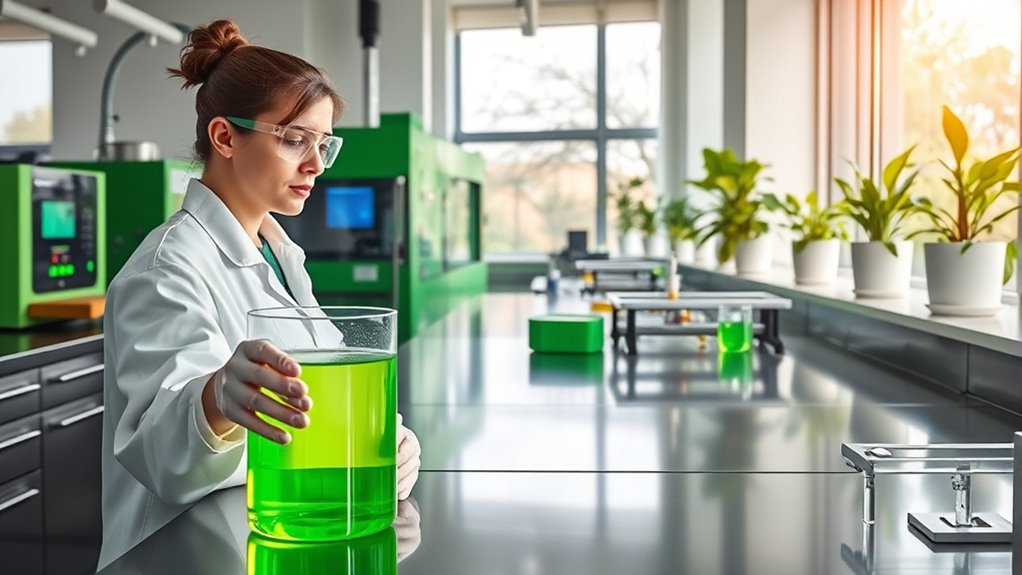
Advancements in green chemistry and technology are shaping the future of sustainable pharmaceutical manufacturing. You’ll see increased use of AI and machine learning to predict reactions, optimize processes, and cut waste. These digital tools can analyze vast datasets to identify greener reaction pathways and reduce trial-and-error in process development. Enzyme catalysis and synthetic biology will make drug synthesis more efficient and eco-friendly by reducing hazardous chemicals and harnessing biological systems. Innovations in biocatalysts will further enhance the selectivity and efficiency of these biological processes, minimizing waste. Continuous flow reactions offer streamlined production, decreasing waste and energy use. Gen AI helps design drugs with better biodegradability and lower toxicity. Future research focuses on developing more effective biocatalysts and sustainable materials. You can expect innovations in catalyst recovery, green solvents, and energy-efficient routes to further minimize environmental impact. These advancements will drive cost savings, improve process efficiency, and help the industry meet growing sustainability standards.
Collaborating for a Greener Pharmaceutical Industry

Collaborating across sectors is essential to creating a greener pharmaceutical industry. Industry-wide partnerships bring together pharmaceutical companies, regulatory agencies, and environmental groups to develop sustainable waste management solutions. These collaborations lead to the creation of standards and best practices, fostering innovation in eco-friendly disposal methods and biodegradable packaging. Working with waste management firms helps establish efficient systems that reduce environmental impact. Additionally, joint research focuses on recyclable materials and reuse strategies, minimizing waste generation. You can also implement waste segregation at the source, enabling better recycling and reducing hazardous waste costs. Advanced tracking technologies help monitor waste flows, ensuring regulatory compliance and optimizing disposal processes. Incorporating self-awareness into sustainable practices can further enhance environmental responsibility, making it easier to adopt and maintain eco-friendly initiatives. Through training and engagement, you and your team can adopt sustainable practices, making environmental responsibility a core part of pharmaceutical manufacturing.
Frequently Asked Questions
How Can Small Pharmaceutical Companies Implement Sustainable Waste Management Practices Effectively?
You can implement sustainable waste management practices effectively by starting with proper waste segregation at the source using clear labels and automated tools to reduce errors.
Switch to eco-friendly packaging and materials, and partner with certified waste handlers.
Focus on waste minimization strategies like recycling and reuse, incorporate energy-efficient equipment, and leverage technology like AI for smarter waste tracking.
Training your staff and involving stakeholders will guarantee long-term success and compliance.
What Are the Most Promising Biodegradable Materials for Pharmaceutical Packaging?
Like turning back the clock to simpler times, biodegradable materials hold promise for pharmaceutical packaging. You should consider plant-based options like cornstarch, cellulose, and mushroom-derived bioplastics, which naturally decompose without harm.
These materials are durable, cost-effective, and eco-friendly, aligning with growing consumer and regulatory demands. By adopting biodegradable packaging, you can reduce waste, improve safety, and contribute to a sustainable future for healthcare.
How Can Patient Education Improve Pharmaceutical Waste Disposal Behaviors?
You can improve pharmaceutical waste disposal behaviors by educating patients about proper methods. When you provide clear, accessible information on disposal options like take-back programs and mail-back services, patients become more likely to follow safe practices.
Using multiple channels such as brochures, online resources, and counseling, you’ll increase awareness, reduce unsafe disposal, and protect the environment. Empowered and informed patients are more responsible, helping lessen contamination and misuse risks.
What Incentives Exist for Companies Adopting Green Manufacturing Technologies?
When it comes to incentives, the ball’s in your court. You’re encouraged by regulatory frameworks like the EU’s CSRD, which pushes for sustainability reporting, and regional compliance that rewards eco-friendly practices.
Economic benefits, such as cost savings and improved operational efficiency, motivate adoption. Plus, environmental gains like reduced carbon footprints and water conservation align with global goals.
These incentives boost your reputation, making green tech a win-win for your business and the planet.
How Do Environmental Criteria Influence New Drug Development Processes?
Environmental criteria shape your drug development process by prompting you to assess potential ecological impacts early on. You’re encouraged to use predictive tools and conduct environmental assessments, which help identify and deprioritize high-impact compounds.
These criteria also push you to incorporate greener design principles, reduce emissions, and select sustainable materials. As a result, your development process becomes more environmentally responsible, aligning with regulatory standards and fostering innovation in eco-friendly pharmaceuticals.
Conclusion
By embracing sustainable practices, you can substantially cut pharmaceutical waste—currently, the industry generates over 15,000 tons of waste annually. Adopting green chemistry, innovative packaging, and stronger regulations not only benefits the environment but also boosts your company’s efficiency and reputation. Together, you can lead the way toward a greener future, ensuring medicines are produced responsibly for generations to come. Every step you take makes a meaningful difference in creating a healthier planet.
